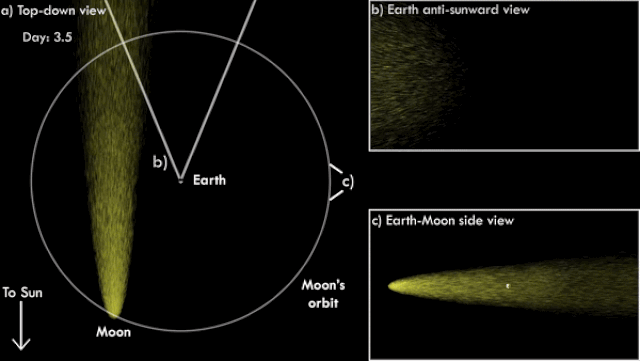The moon has a tail, and Earth wears it like a scarf once a month
The moon has a tail, and Earth wears it like a scarf once a month
The tail is invisible to the naked eye but appears on all-sky cameras during every new moon. – Said livescience.com

Like a comet soaring through the cosmos, the moon is followed by a slender tail of irradiated matter, and Earth passes directly through it once a month [again, every New Moon]. According to a study published March 3 in the journal JGR Planets [Long‐Term Observations and Physical Processes in the Moon’s Extended Sodium Tail], the lunar tail is made of millions of sodium atoms blasted out of the lunar soil and into space by meteor strikes and then pushed hundreds of thousands of miles downstream by solar radiation. For a few days a month, as observed from, from 2006 to 2019 [ 21,000 images of the moon] when the new moon sits between Earth and the sun, our planet’s gravity drags that sodium tail into a long beam that wraps around Earth’s atmosphere before blasting into space on the opposite side.
Abû-Ma’shar said that every element in the skies/cosmos with a tail is not a good source for astrological reasons, yet apparently he understood the Moon as benefic but knew it also corresponded to the “abundance of illness”. The Moon is seen both as malefic and benefic throughout the cultures of our ancestors. But they all agreed as it seems, that the Moon is the great body of “inception of all works” in life. A high-powered telescope can detect the faint orange glow of the exploding beam of sodium once a month. Working with the Moon can be quite subtle and velutinous – According to the study’s authors, the beam then appears as a fuzzy, glowing spot in the sky opposite the sun, about five times the diameter of the full moon and 50 times dimmer than human eyes can perceive.
The Moon is known for its fluctuations & Preganancy – Researchers first detected this “sodium spot” in the 1990s. But while the spot always appears at the same time in the lunar cycle, its brightness fluctuates wildly.
The livescience also wrote that the scientists noticed a few predictable patterns — for example, the spot appeared brighter when the moon’s orbit brought it closer to Earth — but also an unexpected one. Meteor data showed that the moon’s tail glowed more brightly during months when the rate of sporadic meteors (that is, meteors that aren’t part of a regular shower) was higher over Earth. When Earth gets pummeled by meteors, so does the moon. And sporadic meteor encounters had an even greater correlation with the moon spot’s brightness than recurring showers, such as the Leonid meteor shower, which peaks every November.
If a large enough asteroid crashed into the moon with enough force, it could even produce a sodium spot that anyone on Earth could see with the naked eye, James O’Donoghue, a planetary scientist at the Japan Aerospace Exploration Agency, told The New York Times.
In astrology, the astrolger will tell you it takes time for the Moon’s election to have impact, let’s put it. Sometimes rather seen during Full Moons that preceeds such event that was put in practice during a New Moon supposedly, where now we know how visible its orange vibrating sodium beam tail is because of its monthly phenomenon, leaving from the ignorance of what was once invisible to us.
With such incrediable scientific fact before us, we could easily tell what we always knew, with the astrologicalMoon and its “inception” time, which is that there is always something that follows, that preceeds.
